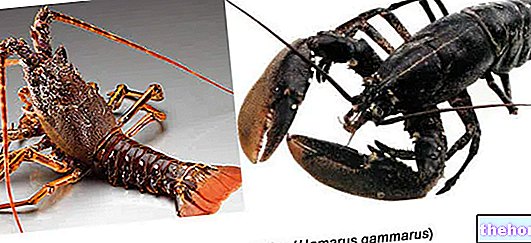What are the Scallops
The scallops or shells of S. Giacomo - Pectinidae family, genus Pecten and species P. jacobaeus - are bivalve molluscs (or lamellibranchs) edible and (from a gastronomic point of view) very valuable; of the scallops if the walnut (muscle) and the coral (gonads) inside are consumed, while the viscera should be carefully excluded through cleaning and processing the animal. NB. The gonads (coral) of the scallops are red or grayish , depending on the sexual variation in progress (hermaphroditism); furthermore, we remind you that the cholesterol content of this organ could vary considerably according to the season and to the presence or absence of reproductive "fregola" (which significantly increases its concentrations).

Description
Adult scallops reach dimensions that sometimes exceed 15cm in diameter, therefore they are larger than the average of Mediterranean bivalve molluscs (with the exception of Pinna nobilis - almost 1 meter in length); they are composed of two external ribbed shells (ribbed), of which one is rounded and the other is flat (on which the mollusk adheres more). The external color of the scallops varies from white, prevalent in the rounded shell, to brown, typical of the flat shell, both internally have a dark edge along the entire indentation, near the opening orifice.
Not everyone knows that scallops are able to move in water very effectively. This is made possible by the rapid opening-closing sequence of the shells, a sort of "breath" of the water that gives rise to a real propulsion. Furthermore, the scallops boast a visual ocular system which, although rather primitive, clearly distinguishes them. from most other bivalves.

Nutritional values (per 100 g of edible portion)
Scallops are typical and endemic of the biodetritic bottoms (25-200m deep) of the Mediterranean Sea, where they reproduce between the months of May and June; however, some biologists speculate that scallops constitute a parallel variety of the "great scallop" (Pecten maximus), instead more distributed in the oceans; both species (or varieties) feed on plankton and organic particles filtered through the gills.
Fishing
The scallops are fished with the rapid trawl technique and it is very important to underline that, especially in the northern Adriatic area, the considerable commercial demand and the illusion of being faced with an unlimited resource has led fishermen to neglect the "eventuality that a gradual exhaustion of the resource occurs; to date, it seems that an annihilation of scallops (and more) is actually taking place.
In the kitchen
From the food point of view, the scallop is particularly appreciated raw with a little melted butter (but it is not recommended for hygienic reasons), or cooked in all ways: in a pan and in the accompanying sauces, grilled, baked. and steamed.

Nutritional characteristics
The nutritional content of scallops does not present excellent characteristics and, considering that a portion of shellfish (net of the edible part) rarely reaches 80-100g (an aspect mainly linked to the costs of the raw material), it is an animal product with a dietary impact. almost marginal.
Scallops are a low-calorie food, low in energy lipids (most of which are polyunsaturated or good fats) and low in cholesterol; the proteins, while boasting a high biological value, are not particularly abundant and, like the other animals of the same group, also the scallops contain a small part of carbohydrates (not surprisingly, the taste of the scallop is "sweetish").
The vitamins contained in scallops are not worth mentioning, except for niacin which appears in greater quantities. As far as mineral salts are concerned, scallops contain a fair amount of potassium, phosphorus and sodium (the latter, unsuitable for the hypertensive diet).
Being a potentially allergenic mollusc, scallops are not recommended for feeding pregnant women and babies.
Scallops au gratin with pistachios
Problems with playing the video? Reload the video from youtube.
- Go to the Video Page
- Go to the Video Recipes Section
- Watch the video on youtube
Bibliography:
- S.callops: Biology, Ecology and Aquaculture - S .. E. Shumway, J. G.J. Parsons - Elsevier - page 28




























